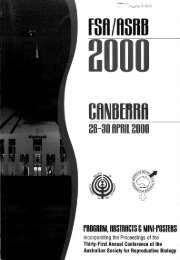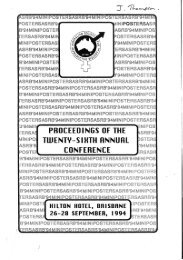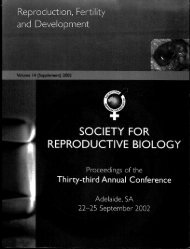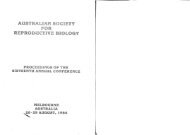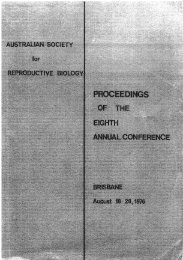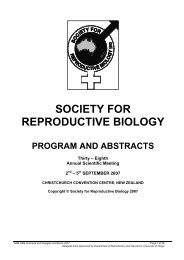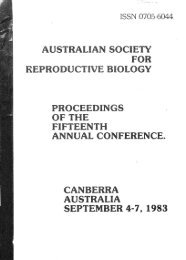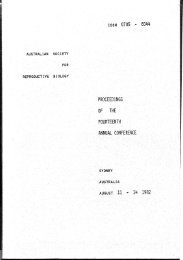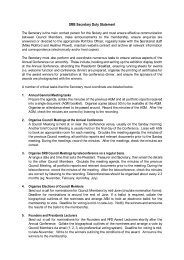N OCIETY' - the Society for Reproductive Biology
N OCIETY' - the Society for Reproductive Biology
N OCIETY' - the Society for Reproductive Biology
Create successful ePaper yourself
Turn your PDF publications into a flip-book with our unique Google optimized e-Paper software.
SEMEN COLLECTION, CHARACTERISATION AND CRYOPRESERVATION IN A MAGELLANICPENGUIN (Spheniscus magellanicus).J. K. O'Brien, D. A. Oehler, S. P. Malowski and T. L. RothCenter <strong>for</strong> Research ofEndangered Wildlife, Cincinnati Zoo and Botanical Garden, Cincinnati, Ohio 45220, USA.IntroductionSeven of <strong>the</strong> 17 penguin species in existence areendangered (1). A better understanding of avianreproduction and <strong>the</strong> application of assisted breedingtechniques such as semen preservation and artificialinsemination (AI) may become important <strong>for</strong> captivepropagation and long-term survival of <strong>the</strong>se species.However, in<strong>for</strong>mation on ejaculate characteristics andsemen preservation is not available <strong>for</strong> any penguinspecies. The Magellanic penguin is not endangered, butits reproductive success in <strong>the</strong> wild has been decliningduring <strong>the</strong> past decade (2). The objectives of <strong>the</strong>present study were to: (i) develop a cooperative method<strong>for</strong> collecting Magellanic penguin semen; (ii)characterise <strong>the</strong> ejaculate parameters and semenproduction during a breeding season; (iii) compareholding temperatures <strong>for</strong> short-term storage; and (iv)compare cryoprotectants <strong>for</strong> long-term storage.Materials & MethodsSemen was obtained from a hand-reared adult maleusing a cooperative collection method. Ejaculates wereassessed <strong>for</strong> volume, pH and osmolality. Sperm qualitywas assessed by evaluating motility and <strong>for</strong>wardprogression (sperm motility index, SMI), viability(Hoechst 33258) and morphology.For short-term storage (n=3 replicates), semen wasdiluted (1:3; semen:diluent) with Beltsville PoultrySemen Extender (BPSE; 3) within 10 min of collection.BPSE pH and osmolarity were adjusted to simulateMagellanic penguin semen pH (7.4 ± 0.5) andosmolarity (430 ± 10 mosm/kg). The diluted semen wasdivided into 2 aliquots and held at 4°C or 21°C. Spermquality assessments were made at 0, 1 and 3 h postdilution.For long-term storage (n=3 replicates), diluted (l:1)semen was fur<strong>the</strong>r diluted (1:1) with BPSE containingdimethylsulfoxide (DMSO) or ethylene glycol (EG),and equilibrated <strong>for</strong> 15 min (final cryoprotectantconcentration: 8%). Straws were frozen on dry ice <strong>for</strong> 5min and transferred to liquid nitrogen. Semen wasthawed (n=2 straws/sample) by holding straws <strong>for</strong> 5 sinair and <strong>the</strong>n by placing <strong>the</strong>m in a 50°C waterbath <strong>for</strong> 10s. Data were analysed by analysis of variance, andmeans were compared using Students t-tests or LSDtests. P0.05) in spermcharacteristics between treatments <strong>for</strong> short-termstorage, although <strong>the</strong>re appeared to be a slightadvantage to maintaining semen at 4°C. Semen samplesmaintained high numbers of viable (77.8 ± 5.4%) andmorphologically normal (67.9 ± 2.5%) sperm at 3 hours(data <strong>for</strong> both treatments combined). SMI and percentviability decreased (P0.05) ascryoprotectants <strong>for</strong> penguin spermatozoa (data notshown). Frozen-thawed semen maintained 68.5 ± 4.6%and 78.4 ± 3.2% of its pre-freeze SMI and viability,respectively (data pooled <strong>for</strong> cryoprotectant). Both SMIand viability remained relatively stable during <strong>the</strong> 3 hstorage interval post-thaw (Table 1). Similar to freshlycollected ejaculates, frozen-thawed semen exhibited anincrease in bent cells (P



